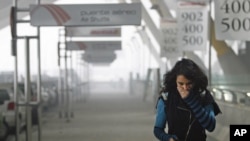Explosive weapons, including aerial and car bombs, rockets, mortars and missiles kill and maim thousands of civilians every year. Eight humanitarian groups recently formed a new organization to curb the use of these deadly weapons in heavily-populated urban areas by governments and rebels. It was in Geneva where the so-called International Network on Explosive Weapons was created.
Recent bombings of civilians in ongoing conflicts in Libya, Ivory Coast and Gaza highlight the human suffering caused by explosive weapons in populated areas.
The use of explosive weapons in Libya’s city centers by government forces and rebel groups has caused widespread devastation. In March, the shelling of a market in Ivory Coast’s commercial capital, Abidjan, killed up to 30 civilians and wounded about 60 more.
A recent spike in the use of explosive weapons in populated areas of both Gaza and Israel has resulted in a sharp increase in civilian casualties, especially among children.
Esther Cann is a research coordinator for Action on Armed Violence and an author of a study on Explosive Weapons in Populated Areas. She said the impacts of these devices often are indiscriminate, severe and far reaching.
"When populated areas are bombed, up to 90 percent of the casualties are civilians. In the last six months, at least 10,000 civilians have been killed and injured by explosive weapons in populated areas. So, while some of these casualties are happening in well-known contexts that we hear about in the news every day, like Afghanistan, Iraq and Libya, they are also a really big problem in places that we hear about less like Burma, Mexico and Sudan."
Cann said the harm done to civilians by these explosive devices is unacceptably high. At the same time, she said governments have failed to justify their military value.
"So, we think that states and uses of explosive weapons should be clear and transparent, and that they should tell us how they assess the damage they cause, that they should publish the data and that should be used to assess the victims. Our research, that we presented in the report shows that this can be done."
Thomas Nash, communications coordinator for the International Network of Explosive Weapons, said, "What this Network is saying is that governments have a responsibility to measure the impact of what they are doing and to make a serious genuine evaluation before they undertake a strike about whether this is going to be unacceptable in terms of civilian damage.
"And, this is really an issue with quite a drastic scope. If we think about the use of bombs in populated areas and civilian areas. It is happening all the time and it is causing a huge amount of humanitarian suffering."
Nick Martlew of Save the Children said it is not possible to know how many of the civilian casualties caused by explosive weapons are children. But, he said evidence suggests children make up a substantial proportion of those killed and injured.
"The impacts on children of the use of explosive weapons in populated areas, that is a global menace on children," he said. "That is, unfortunately, not exceptional… So, from Afghanistan to Yemen, from Sri Lanka to Somalia, children are facing horrific injury and lasting damage from these explosive weapons."
Martlew said children suffer greater physical distress than adults from explosive weapons.
"Children’s bodies offer them less protection than ours do. Explosive blasts produce complex injuries that are harder to heal. And, recovery can be tortuous because children’s bodies are still growing. But, the damage is not just physical. Children disabled by a mortar shell or by an IED (improvised explosive device) are more likely to be exploited or neglected. The emotional trauma is going to be greater because he is still going through childhood and development," said Martlew. "And, children affected by this kind of violence are more likely to have difficulty concentrating in school, if their school is still standing."
The International Network on Explosive Weapons may be a new organization. But, its membership is made up of veterans of previous battles against weapons that cause inordinate harm to civilians.
Several of the groups, such as Handicap International, Human Rights Watch and Oxfam, played major roles in the movement that succeeded in achieving the 1997 treaty to ban land mines. They also had a hand in getting an international agreement limiting the use of cluster weapons signed in 2008.
The Network believes it can achieve a similar success in restricting the use of explosive weapons.
News
Group Aims to Curb Use of Explosive Weapons
- By Lisa Schlein





